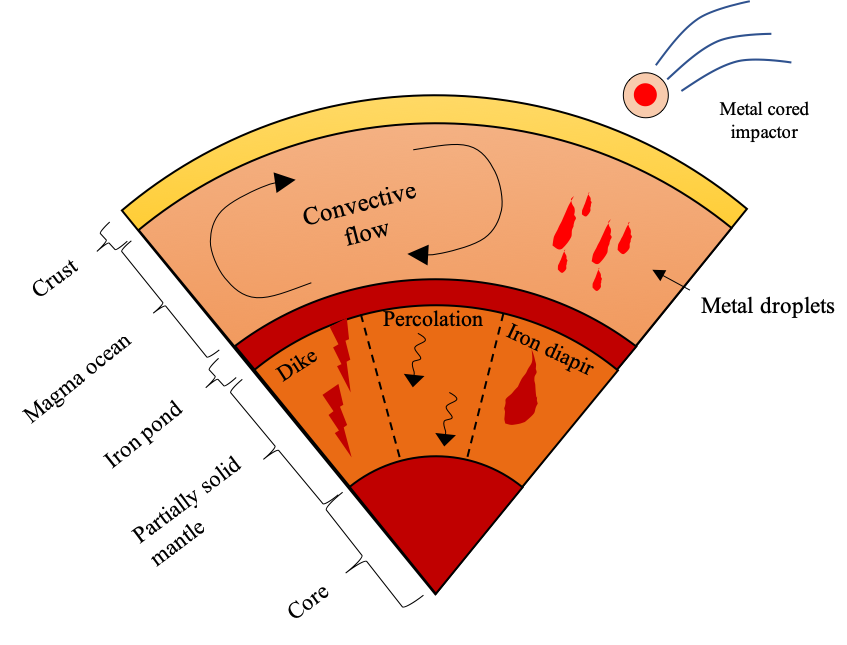Primitive mantle on:
[Wikipedia]
[Google]
[Amazon]
 In
In
 In
In geochemistry
Geochemistry is the science that uses the tools and principles of chemistry to explain the mechanisms behind major geological systems such as the Earth's crust and its oceans. The realm of geochemistry extends beyond the Earth, encompassing the e ...
, the primitive mantle (also known as the ''bulk silicate
A silicate is any member of a family of polyatomic anions consisting of silicon and oxygen, usually with the general formula , where . The family includes orthosilicate (), metasilicate (), and pyrosilicate (, ). The name is also used ...
Earth'') is the chemical composition of the Earth's mantle
Earth's mantle is a layer of silicate mineral, silicate rock between the Earth's crust, crust and the Earth's outer core, outer core. It has a mass of and makes up 67% of the mass of Earth. It has a thickness of making up about 46% of Earth's ...
during the developmental stage between core-mantle differentiation and the formation of early continental crust
Continental crust is the layer of igneous, metamorphic, and sedimentary rocks that forms the geological continents and the areas of shallow seabed close to their shores, known as '' continental shelves''. This layer is sometimes called '' si ...
. The chemical composition of the primitive mantle contains characteristics of both the crust and the mantle.
Development
One accepted scientific hypothesis is that the Earth was formed by accretion of material with a chondritic composition through impacts with differentiated planetesimals. During this accretionary phase, planetary differentiation separated the Earth's core, where heavy metallic siderophile elements accumulated, from the surrounding undifferentiated primitive mantle. Further differentiation would take place later, creating the different chemical reservoirs of crust and mantle material, with incompatible elements accumulating in the crust. Today, differentiation still continues in theupper mantle
The upper mantle of Earth is a very thick layer of rock inside the planet, which begins just beneath the crust (geology), crust (at about under the oceans and about under the continents) and ends at the top of the lower mantle (Earth), lower man ...
, resulting in two types of mantle reservoirs: those depleted in lithophile elements (''depleted reservoirs),'' and those composed of "fresh" undifferentiated mantle material (''enriched'' or ''primitive reservoirs)''. Volcanic rock
Volcanic rocks (often shortened to volcanics in scientific contexts) are rocks formed from lava erupted from a volcano. Like all rock types, the concept of volcanic rock is artificial, and in nature volcanic rocks grade into hypabyssal and me ...
s from hotspot areas often have a primitive composition, and because the magma
Magma () is the molten or semi-molten natural material from which all igneous rocks are formed. Magma (sometimes colloquially but incorrectly referred to as ''lava'') is found beneath the surface of the Earth, and evidence of magmatism has also ...
at hotspots is supposed to have been taken to the surface from the deepest regions of the mantle by mantle plume
A mantle plume is a proposed mechanism of convection within the Earth's mantle, hypothesized to explain anomalous volcanism. Because the plume head partially melts on reaching shallow depths, a plume is often invoked as the cause of volcanic ho ...
s, geochemists assume there must be a relatively closed and very undifferentiated primitive reservoir somewhere in the lower mantle. One hypothesis to describe this assumption is the existence of the D"-layer at the core-mantle boundary.
Chemical composition
Although the chemical composition of the primitive mantle cannot be directly measured at its source, researchers have been able to estimate primitive mantle characteristics using a few methods. One methodology involves the analysis of chondritic meteorites that represent early Earth chemical composition and creating models using the analyzed chemical characteristics and assumptions describing inner-Earth dynamics. This approach is based on the assumption that early planetary bodies in theSolar System
The Solar SystemCapitalization of the name varies. The International Astronomical Union, the authoritative body regarding astronomical nomenclature, specifies capitalizing the names of all individual astronomical objects but uses mixed "Sola ...
formed under similar conditions, giving them comparable chemical compositions. The more direct methodology is to observe trends in the chemical makeup of upper mantle peridotites and interpret the hypothetical composition of the primitive mantle based on these trends. This is done by matching the peridotite
Peridotite ( ) is a dense, coarse-grained igneous rock consisting mostly of the silicate minerals olivine and pyroxene. Peridotite is ultramafic, as the rock contains less than 45% silica. It is high in magnesium (Mg2+), reflecting the high pr ...
compositional trends to the distribution of refractory lithophile elements (which are not affected by core-mantle differentiation) in chondritic meteorites. Both methods have limitations based on the assumptions made about inner-earth, as well as statistical uncertainties in the models used to quantify the data.
The two approaches detailed above yield weight percentages that follow the same general trends when compared to the depleted (or homogeneous) mantle: the primitive mantle has significantly higher concentrations of SiO2, Al2O3, Na2O, and CaO, and significantly lower concentrations of MgO. More importantly, both approaches show that the primitive mantle has much greater concentrations of refractory lithophile elements (e.g Al, Ba, Be, Ca, Hf, Nb, Sc, Sr, Ta, Th, Ti, U, Y, Zr, and rare earth elements). The exact concentrations of these compounds and refractory lithophile elements depends on the estimation method used. Methods using peridotite analysis yield a much smaller primitive mantle weight percentage for SiO2 and significantly larger primitive mantle weight percentages for MgO and Al2O3 than those estimated using direct chondritic meteorite analysis. The estimated concentrations of refractory lithophile elements obtained from the two methods vary as well, usually 0.1-5 ppm.{{Citation, last=Yanagi, first=Takeru, title=Chemical Composition of Continental Crust and the Primitive Mantle, date=2011, url=https://doi.org/10.1007/978-4-431-53996-4_2, work=Arc Volcano of Japan: Generation of Continental Crust from the Mantle, pages=9–17, editor-last=Yanagi, editor-first=Takeru, series=Lecture Notes in Earth Sciences, volume=136 , place=Tokyo, publisher=Springer, language=en, doi=10.1007/978-4-431-53996-4_2, isbn=978-4-431-53996-4, access-date=2021-11-09, url-access=subscription
See also
* Giant impact hypothesisReferences